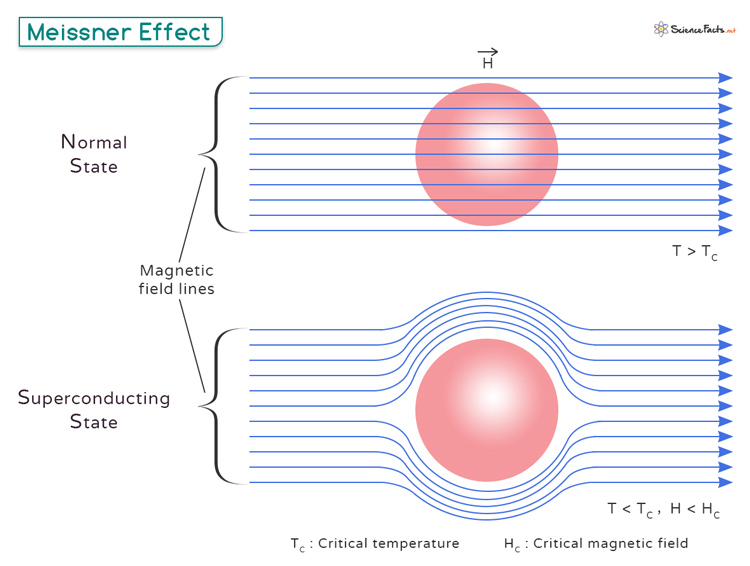Meissner Effect
The Meissner effect is a phenomenon closely associated with superconductivity. When a material becomes a superconductor, it can expel all magnetic fields from its interior. This happens when the material is cooled below a specific temperature called the critical temperature. As a result, the superconductor loses all resistance to electrical current, allowing electricity to flow without any loss of energy.
German physicists Walther Meissner and Robert Ochsenfeld discovered this phenomenon in 1933, and it is considered one of the defining characteristics of superconductivity.
How Does it Work
Above the critical temperature (Tc), a superconductor allows a magnetic field to pass through it without any significant effect. However, when the superconductor is cooled below its critical temperature, the applied magnetic field is expelled from its interior and redirected around it, as shown in the figure. This expulsion happens because surface currents, which flow without resistance, create a magnetization within the superconductor. This magnetization is equal and opposite to the external magnetic field, effectively canceling it out inside the superconductor. As a result, the superconductor exhibits perfect diamagnetism, which is characterized by a magnetic susceptibility (χ) of -1.
Theoretical Explanation
The theoretical explanation for the Meissner Effect is based on the London equations, developed by brothers Fritz and Heinz London in 1935. These equations describe how superconductors behave in the presence of electromagnetic fields and help us understand the perfect diamagnetism seen in the Meissner effect.
According to the London equations, the magnetic field inside a superconductor decreases rapidly from the surface over a specific distance called the London penetration depth. This distance is very small, typically in the range of tens to hundreds of nanometers (10 – 100 nm). The London penetration depth is important because it tells us how far the magnetic field can penetrate into the superconductor before it is completely expelled.
This decrease occurs because persistent supercurrent loops form within the superconductor, creating a magnetic field that opposes the applied field and effectively expels it from the inside. These supercurrents flow without any resistance, which is why they can generate a magnetic field strong enough to counteract and cancel the external magnetic field. As a result, the interior of the superconductor remains free of magnetic fields, demonstrating perfect diamagnetism.
Application
The Meissner effect has several practical applications. Here, we will discuss its key application, which is magnetic levitation. Often called Maglev, magnetic levitation uses the Meissner effect to make things float and move without touching anything (no friction).
In a Maglev system, superconducting materials are used to construct the vehicle, while the track is embedded with powerful magnets. As the superconducting vehicle passes over the magnetized track, the Meissner effect creates a repulsive force between the superconductor and the magnetic field, causing the vehicle to levitate above the track. By controlling the magnetic fields along the track and the orientation of the superconductor, the levitating vehicle can be propelled forward, allowing for efficient and frictionless transportation. Therefore, this technology offers advantages over traditional wheeled transportation methods.
-
References
Article was last reviewed on Tuesday, August 6, 2024








